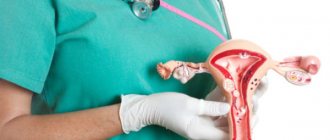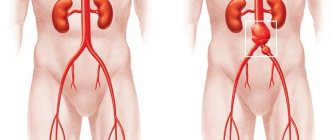There are many diseases that can reduce a woman’s quality of life, provoke discomfort, and cause infertility. One of these pathologies is prolapse or prolapse of the uterus. It is characterized by displacement of the cervix and uterine fundus below the natural anatomical border. The main reason is considered to be weakening of ligaments and muscles. Accompanied by nagging pain in the abdomen, difficulty urinating, and pathological vaginal discharge. If treatment is not started on time, displacement of the uterus is fraught with partial or complete prolapse, the inability to have children and other complications.
Types of disease
The uterus in its physiological position is located in the upper part of the small pelvis, holding the dome of the vagina. The organ is securely fixed by the ligamentous apparatus, multiple fascia and muscles, creating a flexible but durable frame for the entire peritoneum.
Normally, the uterus can move and deviate within small limits. The weakening of any group of tissues supporting it causes the organ to shift into the vagina and gradually slide (prolapse) towards the exit from the perineum.
Depending on which muscles or ligaments have ceased to perform their supporting function, prolapse can develop in the anterior (about 30% of cases), middle or posterior sections. The condition is complicated by the fact that displacement of the uterus changes the position of surrounding organs and also leads to deformation of the vaginal walls.
Types of pathology:
- partial prolapse - the body of the uterus changes position without leaving the vagina, or protrudes beyond the boundaries of the genital slit by no more than 1 cm;
- complete prolapse (apical prolapse) – loss of the entire organ;
- cystocele – a condition accompanying displacement of the uterus and anterior vaginal wall, with bladder prolapse;
- Rectocele is a pathology that occurs due to pressure from the shifting uterus and posterior vaginal wall, leading to protrusion of the rectum.
There is a complex classification of different types of pelvic organ prolapse in women. Even a slight displacement of the uterus can cause complications from previous injuries, sprains, which provokes not only cystocele or rectocele, but sometimes prolapse of intestinal loops (enterocele), urethral prolapse, as well as various combined pathologies.
What it is
Uterine prolapse is a pathology in which partial or complete displacement of an organ outside the vagina occurs. Her body is pear-shaped and is located between the rectum and bladder.
A powerful layer of muscle tissue and ligaments is located around, providing support to the body of the uterus and protection from intra-abdominal pressure. If the muscle corset weakens, losing its elasticity and firmness, the organ will begin to shift.
Stages and degrees
At an early stage of the process, the displacement of the uterus is slight and does not have specific symptoms. The pathology develops slowly, starting at any age, it can reveal itself only in premenopause or after the attenuation of hormonal functions. Although sometimes, with accompanying aggravating factors, prolapse can increase rapidly.
According to the degree of prolapse of the uterine body into the vagina, 4 stages of pathology are distinguished:
| Stage | Description | Symptoms |
| I | A slight displacement of the cervix down the vagina, the walls are somewhat weakened, the genital slit may not close | Menstrual irregularities, possible discomfort during sexual intercourse |
| II | The body of the uterus is displaced downward, but is located inside the vagina; when straining, the cervix of the organ protrudes from the genital slit | Sensation of a foreign object in the vagina, frequent urge, impossibility (difficulty) of sexual intercourse, severe nagging pain, incomplete emptying of the bladder |
| III | The cervix and part of the uterus gape from the vagina even at rest, the organ is susceptible to pinching and traumatization | Discomfort (pain) when walking and sitting, discharge mixed with blood, infection of the uterus and surrounding tissues is often observed |
| IV | Prolapsus uteri. The organ and walls of the vagina are completely outside the boundaries of the genital opening | Severe pain, inability to sit, bedsores, abscesses, inflammation in areas of organ friction |
Uterine prolapse reveals symptoms and consequences as the pathology progresses. In addition to mechanical displacement of organs, disturbances in the functions of urination, defecation, infection of the bladder, kidneys, and other concomitant diseases are naturally noted.
Diagnosis of uterine prolapse and prolapse
The gynecologist can be the first to detect this pathology during a routine examination. Through simple manipulations and actions, the doctor determines the degree of displacement of the uterus. If the suspicions are justified, the woman is registered and must undergo mandatory routine checks and colcoscopy.
In some cases, plastic manipulation is required.
In some cases, the following procedures are prescribed:
- Curettage of the uterus for diagnostic purposes;
- Ultrasound of the pelvic organs;
- Smear examination;
- Urine and stool tests;
- Urography;
- CT.
A consultation with a proctologist and urologist is required. This consultation is prescribed to find a rectocele or cystocele, and also to assess whether there are any deformities in the rectum.
Prolapse and prolapse of the uterus is an independent disease; it in no way relates to inversion, cyst formation or other complications of the uterine tract.
Symptoms
Clinical signs of uterine prolapse are nonspecific and at the beginning can be mistaken for a common illness. Symptoms that allow one to independently suspect uterine prolapse appear at stages when surgical intervention is no longer possible.
You should be especially careful about any unusual sensations during sexual intercourse. Accumulation of air, fluid, pain or weak closure of the vagina requires an urgent visit to the gynecologist to assess the condition of the vagina and the height of the cervix.
Classic signs that the uterus has deviated from its normal position or is moving downward:
- sensation of a foreign body in the vagina;
- discomfort when walking, sitting;
- feeling of pressure and heaviness in the lower abdomen;
- drawing pain in the sacrum, behind the pubic bone;
- swelling of the labia or “everting” of the vagina at the border of the genital slit;
- frequent cases of cystitis, incontinence when sneezing, coughing, or, conversely, congestion in the bladder.
- frequent cases of cystitis, infections of unknown origin, pyelonephritis;
- pain during (after) sexual intercourse, discharge with blood after sex;
- difficulty with bowel movements.
In the last stage of prolapse, the uterus emerges from the vagina
One of the most striking symptoms of prolapse of the uterus and surrounding organs is non-closure of the genital opening; it can appear in the early stages, but is not perceived as a serious signal of trouble.
A gaping entrance to the vagina provokes drying of the mucous membrane and facilitates the penetration of infections. Thus, secondary diseases lead women to a doctor who can detect uterine prolapse during a standard gynecological examination.
In women of reproductive age, uterine displacement can be suspected by a change in the nature of menstruation. They become abundant, long-lasting and painful. Pain from swelling may persist after the bleeding has stopped.
Consequences
If the disease is diagnosed in a woman of fertile age, she often has the question of whether it is possible to become pregnant if the walls of the uterus prolapse. Yes, there are no special obstacles to conception in the early stages if the disease is asymptomatic. If the prolapse is significant, then before a planned pregnancy it is better to undergo surgery 1-2 years before conception.
Maintaining pregnancy with proven uterine prolapse is fraught with difficulties . Is it possible to carry a child to term with this disease? Of course, yes, although the risk of pregnancy pathology, miscarriage, premature and rapid labor, and bleeding in the postpartum period increases significantly. In order for the pregnancy to develop successfully, you need to be constantly monitored by a gynecologist, wear a bandage, use a pessary if necessary, engage in physical therapy, and take medications prescribed by your doctor.
What are the dangers of uterine prolapse in addition to possible problems with pregnancy:
- cystitis, pyelonephritis – urinary system infections;
- vesicocele - a saccular expansion of the bladder in which urine remains, causing the sensation of incomplete emptying;
- urinary incontinence with perineal skin irritation;
- rectocele - expansion and prolapse of the rectal ampulla, accompanied by constipation and pain during bowel movements;
- infringement of the intestinal loops, as well as the uterus itself;
- uterine inversion followed by necrosis;
- deterioration in the quality of sexual life;
- decrease in the overall quality of life: a woman is embarrassed to go out into public places because she constantly has to run to the toilet, change incontinence pads, she is exhausted by constant pain and discomfort when walking, she does not feel healthy.
Reasons for appearance
Uterine prolapse, symptoms and consequences manifest according to the factors that caused the pathology. The process is associated with any weakening of the system of ligaments, muscles, and their fascia that control the position of the uterus. The muscle tone of the perineum and peritoneum can change for many reasons.
Factors that provoke displacement and prolapse of the uterus:
- Difficult childbirth with ruptures, episiotomy (dissection of perineal tissue), improper obstetric care. Vacuum extraction or application of forceps can lead to overstretching and mechanical damage to the vagina, muscles, and ligaments.
- Insufficient attention to the restoration of the body after childbirth, multiple pregnancies.
- Consequences of surgical interventions in the pelvis: scars and adhesions inside the vagina, on the body of the uterus, reproductive organs.
- Congenital pathologies in the structure of the uterus or changes in its shape and position as a consequence of previous diseases.
- High physical activity, regular hypothermia, heavy lifting.
- Estrogen deficiency caused by disease, stress or natural aging processes.
The risk of developing pathology increases if you are overweight, have frequent constipation, or have a constant cough. A combination of several factors significantly increases the likelihood of uterine prolapse. The ligament and muscle corset is weakened due to a sedentary, especially sedentary lifestyle.
Causes
This pathology is provoked by the following external and internal factors:
- age-related weakening of muscle tone;
- tumors;
- difficult childbirth, birth injuries;
- multiple pregnancy;
- obesity;
- chronic constipation;
- gynecological operations;
- chronic cough;
- hard physical labor;
- some sports (weightlifting).
Diagnostics
It is impossible to independently determine uterine displacement in the early stages. At the same time, a routine gynecological examination can detect pathology at the very beginning of development. Early or progressive forms of the disease are detected by a gynecologist by palpation. The condition of the pelvic floor, the tone of the vagina, and the muscles responsible for supporting the organs are assessed during a vaginal-abdominal examination.
The gynecologist determines the stage of prolapse or prolapse by palpation at rest and when the patient strains.
If displacement of the uterus, vaginal walls, or other peritoneal organs is detected, additional studies will be required:
- urine analysis for timely diagnosis of concomitant infections;
- urography, prescribed when there is a risk of blockage of the urinary ducts;
- ultrasound examination of the pelvic organs to detect possible complications;
- Bladder catheterization is required in the presence of concomitant cystocele;
- a rectal examination is prescribed when a rectocele, sphincter weakness, or concomitant hemorrhoids are detected;
- colposcopy, scraping or biopsy are required to examine ulcerations and erosions on the cervix with varying degrees of cancer suspicion.
All procedures can be completed at a public clinic or at a private center.
Average prices for the most necessary studies for uterine prolapse:
- appointment with a gynecologist – from 1000 to 3000 rubles;
- Ultrasound of the pelvis (comprehensive) – 1300 rubles;
- Gynecological ultrasound – 500 rubles;
- Ultrasound of the bladder – from 300 rubles;
- Ultrasound scanning of veins – starting from 300 rubles;
- colposcopy – 300 rubles;
- uterine biopsy – from 600 rubles
- cystoscopy – 900 rubles.
Some studies are prescribed only if it is necessary to differentiate uterine prolapse from cysts, fibroids or cervical cancer. The required set of studies is determined by the doctor.
The essence of the disease, causes
Not a single girl is immune from uterine prolapse. The pathology is experienced by young and old people, but women aged 40–50 years are more susceptible to prolapse of the uterine walls.
The internal organs are held in place by the pelvic floor muscles. They are responsible for regulating intra-abdominal pressure. Muscles are considered a powerful framework that can stretch and recover. During childbirth, they participate in the expulsion of the baby. After the baby is born, the muscles return to their normal position.
Changes in muscle tone can lead to cervical prolapse or prolapse. Lack of therapy leads to a decrease in quality of life and significant discomfort.
The disease is curable. In case of 1st degree uterine prolapse, it is advisable to use conservative approaches. Yoga, Kegel exercises, swimming, exercise on an exercise bike - all this helps in strengthening muscles and preventing displacement. For stage 2 uterine prolapse, non-radical methods are also effective. The third and fourth stages (partial, complete organ loss) are treated surgically. It is not advisable to use candles, vaginal balls, cones, or spin a hoop or hula hoop. Delay in performing the operation is fraught with unpredictable complications.
The development of the disease - uterine prolapse is caused by:
- injuries, ruptures during childbirth;
- acquired, congenital anomalies of the pelvic organs;
- overweight, obesity;
- excessive physical activity;
- previous surgical interventions on the female genital organs;
- hormonal imbalance (a common cause of prolapse in old age);
- genetic predisposition;
- chronic constipation.
Muscle atrophy, multiple births, neoplasms in the abdominal cavity, hard work lead to prolapse of the anterior (posterior) wall of the uterus.
The pathology is serious and can provoke malfunctions of not only the reproductive, but also the urinary system, and also the gastrointestinal tract. Do not hesitate to consult a doctor if prolapse occurs. The sooner treatment begins, the lower the risk of relapse and complications.
When to see a doctor
Any unusual manifestations in the genital area, atypical pain, or changes in the course of menstruation should force a woman to consult a gynecologist. Even if there are no unusual manifestations, regular visits to a specialist (at least once a year) can reveal the first deviations in the position of the uterus or detect muscle weakness and stretching of the fascia.
You should be especially attentive to any signs of uterine displacement immediately after childbirth, in the first year after any surgery on the pelvic organs, as menopause approaches. Women who become pregnant when diagnosed with uterine prolapse should be constantly monitored by a gynecologist.
The pain that accompanies uterine prolapse is difficult to distinguish from symptoms of other conditions. Nagging pain in the sacrum, behind the pubis, and in the lower back can be caused by other gynecological problems, kidney diseases, and spinal pathologies.
In any case, unusual sensations in the vagina, nagging pain, and sexual dysfunction require medical attention. The gynecologist conducts an initial examination and prescribes the necessary studies.
Based on the results of the examination, consultation with specialized specialists may be required: proctologist, urologist, oncologist, surgeon. For varicose veins of the lower extremities and external genitalia caused by pressure on the vessels of the pelvic floor, it is necessary to visit a phlebologist.
Causes and mechanism of development
The disease often begins at a woman’s fertile age, that is, before menopause. Its course is always progressive. As the disease develops, dysfunction of the vagina, uterus, and surrounding organs occurs.
For genital prolapse to occur, a combination of two factors is necessary:
- increased pressure in the abdominal cavity;
- weakness of the ligamentous apparatus and muscles.
Causes of uterine prolapse:
- decrease in estrogen production that occurs during menopause and postmenopause;
- congenital weakness of connective tissue;
- trauma to the perineal muscles, in particular during childbirth;
- chronic diseases accompanied by poor circulation in the body and increased intra-abdominal pressure (intestinal diseases with constant constipation, respiratory diseases with prolonged severe cough, obesity, tumors of the ovaries, kidneys, liver, intestines, stomach).
These factors in various combinations lead to weakness of the ligaments and muscles, and they become unable to hold the uterus in its normal position. Increased pressure in the abdominal cavity “squeezes” the organ down. Since the anterior wall is connected to the bladder, this organ also begins to follow it, forming a cystocele. The result is urological disorders in half of women with prolapse, for example, urinary incontinence when coughing or physical exertion. When the posterior wall subsides, it “pulls” the rectum with it, forming a rectocele in a third of patients. Uterine prolapse often occurs after childbirth, especially if it was accompanied by deep muscle tears.
Multiple births, intense physical activity, and genetic predisposition increase the risk of the disease.
Separately, it is worth mentioning the possibility of vaginal prolapse after amputation of the uterus for another reason. According to various authors, this complication occurs in 0.2-3% of operated patients with a removed uterus.
Prevention
Uterine prolapse, the symptoms and consequences of which are difficult to treat, can be prevented or treated at an early stage.
The following medical measures help to avoid organ prolapse:
- High-quality obstetric care and obstetric support during childbirth, including proper suturing of ruptures in the birth canal and perineum.
- After childbirth, the supporting functions of the pelvic floor are restored using therapeutic exercises, electrical muscle stimulation, and laser therapy.
- Treatment of any diseases accompanied by cough is mandatory. Therapy is carried out until the symptom completely disappears, avoiding chronic conditions.
- Regular constipation or hemorrhoids require examination and timely treatment at any age. All conditions that increase intra-abdominal pressure are dangerous.
- At the first signs of menopause, it is advisable to consult a gynecologist to prescribe hormone replacement therapy. This will prevent a sharp weakening of muscles and ligaments due to a lack of estrogen.
Special exercises to strengthen the muscles of the vagina, abdominal wall and pelvic floor should be performed regularly by all women who have given birth, after reaching 40 years of age, as well as in the presence of any risk factors for uterine prolapse.
Causes of uterine prolapse and prolapse
The main causes of prolapse and prolapse of the uterus can be:
- Deformation or laxity in the pelvic muscles;
- Injuries during childbirth - surgical and natural;
- Vaginal lacerations;
- Disorders of the genitourinary system;
- Pelvic pathologies from an early age, as well as congenital ones;
- Menopause;
- Tissue deformation.
The main factors that can affect the risk of prolapse or uterine prolapse:
- a large number of births;
- great physical activity;
- lifting weights (more than 10 kg);
- age;
- hereditary predisposition;
- overweight;
- cancer;
- constipation or loose stools.
All of the above affects the occurrence of sagging muscles of the pelvic organs. As a result, the pressure increases, and the uterus may descend or fall out, and displacement of other nearby organs may occur.
Lifestyle
Changing certain habits, working and living conditions that lead to weakening of the ligamentous-muscular system or provoke stretching and tearing of internal tissues is also of preventive importance.
Methods for self-prevention of uterine prolapse:
- Maintaining an optimal weight and high physical activity significantly reduce the risk of excess pressure on internal organs. The general tone and toned condition of the abdominal and pelvic floor muscles are ensured by regular sports, fitness, and swimming.
- Despite the indications for playing sports, excessive training, heavy lifting, and overstrain of the peritoneum and lower back should be avoided.
- A balanced diet not only helps control weight, but also eliminates constipation, which is dangerous for internal organs due to excessive straining during bowel movements.
- If early stages of pathology are detected, sexual life is temporarily limited due to the risk of worsening the condition. Starting from stage II, reliable contraception should be ensured, because the onset of pregnancy contributes to the rapid progress of prolapse.
With a sedentary lifestyle, it is difficult to maintain ligamentous apparatus and muscles in tone. Stagnation of blood in the pelvis due to sedentary work is an additional risk factor for any intra-abdominal pathologies. Without regular breaks and special training, there is a danger of sudden organ prolapse with minor exertion.
What to do if you have uterine prolapse in old age
Natural age-related weakening of the pelvic ligaments and insufficient estrogen levels provoke prolapse and complete prolapse of the uterus in older women. Doctors consider surgery to be the most effective treatment, including removal of the organ. If operations are contraindicated for any reason, then uterine rings are installed for patients. Drug (hormonal) treatment is often prescribed. It is recommended to avoid physical activity, adhere to a diet that excludes constipation, and do special gymnastics.
Treatment methods
Uterine prolapse has several treatment options only in the very early stages, while the symptoms are moderate and the consequences have not yet become chronic. At the first stage, it is possible to stop the process with the help of therapeutic exercises, a set of exercises for the abdominal muscles, sphincters, vaginal and pelvic floor muscles.
Exercises
Rules for performing Kegel exercises:
- You can identify the muscle group that needs training while urinating. Squeezing the sphincters, they try to stop the flow. When you manage to do this for longer than 5 seconds, you can repeat the exercise one by one with slight straining.
- You can use this discreet training, retracting the sphincters of the perineum and anus, and then relaxing them for 5 seconds, anywhere: at the workplace, in transport, while driving a car. The exercise is repeated 10 times, the muscles are relaxed for a few minutes, then the complex can be repeated.
- A simple Kegel technique is especially effective during physical activity. When doing abdominal exercises, while riding a bicycle, or doing static stretches, repeat the cycle of squeezing and relaxing the perineum without stopping the workout.
- Gradually make the exercise more difficult by increasing tension, “pulling” the perineum into yourself as much as possible, straining the anus and abdominal muscles. The technique is called a “lock”, it simulates fastening a clasp from the navel through the crotch to the tailbone.
An important condition for the effectiveness of training is the gradual increase in load. In the first weeks of training, try not to overstrain weakened areas, otherwise you can harm the pelvic floor muscles and get pain instead of relief.
Therapeutic exercises for uterine prolapse in the early stages:
- Walk in a circle with a rubber ball (about 15 cm in diameter) held between your thighs. Duration – about 3 minutes.
- Standing with your hands clasped behind your back, raise your arms up, simultaneously rising on your toes and moving your pelvis forward. The head is thrown back and the head is pulled towards the hands, and the pubis is up. At the same time, perform Kegel techniques, straining the muscles of the perineum. Repeat up to 6 times.
- Lying on your back, perform alternating swings with straightened, bent legs, circular movements, bicycle, bringing and spreading straight legs, “scissors”. At the same time, frequent, rapid contractions of the perineal muscles (blinking) are performed.
- Perform flat crawling on your stomach, moving forward and backward for 2 minutes.
- Lying on your stomach, with your arms stretched out in front of you, alternately raise your right arm and left leg and vice versa. Hold each position for several seconds, retracting the vagina as much as possible.
- Sitting on the floor, wearing a tourniquet on your shins, perform leg extensions to the sides and alternate leg lifts, overcoming the resistance of the elastic band. Each technique is performed up to 10 times.
There are many simple exercises that, when combined with Kegel techniques, can strengthen the pelvic muscle corset. Results appear no earlier than after a month of daily training.
You can check the effectiveness of the exercises after 60 days by undergoing a gynecological examination. Any complex of therapeutic exercises must be selected taking into account the stage of uterine prolapse, the characteristics of the disease, and must be approved by a doctor.
Conservative therapy
For prolapse of the vagina and uterus, exercises are combined with the following methods of symptomatic therapy:
- use of pessaries (uterine rings);
- wearing a hysterophore bandage secured around the waist;
- use of large vaginal tampons.
These measures only temporarily alleviate the condition and can have many side effects. Among the undesirable consequences are overstretching of the vaginal walls, pinching of the cervix, the formation of abrasions, bedsores, and erosive lesions with long-term use.
When using such devices, the vagina should be irrigated daily with antiseptics and visit a gynecologist for monitoring at least 2 times a month.
Surgical methods
The only way to eliminate pathology after stage II is surgery. Depending on the degree of prolapse and accompanying disorders, different types of surgical interventions are prescribed.
The most commonly used radical methods are:
- Colpoperineography is a minimally invasive intervention that involves fixing the organ in its normal position using special mesh implants with suturing of the stretched anterior or posterior vaginal wall. The method completely preserves the uterus and its functions. After complete recovery, conception and pregnancy are possible.
- Colporrhaphy - a type of plastic surgery involving excision of a section of the vagina with suturing of muscles. The intervention involves layer-by-layer suturing of the tissues of the deformed posterior or anterior wall, which is also indicated for eliminating postoperative scars. In case of severe prolapse or prolapse of the organ, several consecutive operations are required
- In case of incomplete uterine prolapse in patients with a history of childbirth, the so-called “Manchester” procedure . The operation involves the necessary suturing of the walls, partial removal of the uterine body with rigid fixation of the remaining part. Reproductive function is not preserved.
- Emmett's operation is a cervical plastic surgery performed for incomplete prolapse of the organ. It can be carried out using several methods: surgical, laser, radio wave. During the procedure, part of the uterus is removed, a cervix of the desired size is formed, and it is fixed in its normal position.
- Hysterectomy is one of the most radical methods. It is used in cases of complete, complicated organ prolapse or in menopausal women, when maintaining reproductive function is not relevant. During the operation, the uterus is removed entirely with obligatory fixation of the vaginal dome.
In each case of uterine prolapse, the method is chosen individually, if possible using a low-traumatic approach - laparoscopy. Many fixation methods have been developed, each of which is used depending on the indications. The individual selection of the method is made by the surgeon according to the recommendations of the attending gynecologist.
Even minimally invasive methods of surgical treatment of organ prolapse require long-term recovery in compliance with all doctor’s recommendations. Otherwise, there is a high chance of repeated prolapse or prolapse of the uterus, vaginal dome, intestines, and other organs.
Treatment regimens for uterine prolapse
Every woman faced with this problem is concerned with the question: how to treat uterine prolapse at home and when can you do without surgery? When determining treatment tactics, the doctor takes into account the following points:
- The degree of prolapse and concomitant diseases of the genital organs,
- The severity of symptoms from the urinary organs and intestines,
- The patient's age and the need for childbearing function,
- Risk level of surgery and anesthesia.
Important! Conservative therapy gives results only with 1 degree of uterine prolapse. Refusal to undergo surgery is also due to the woman’s advanced age and the presence of serious illnesses (severe heart failure, oncology, etc.).
Non-surgical treatment methods
Bandage
Complex treatment - the use of various conservative techniques - gives the most lasting effect and permanently eliminates the painful symptoms of uterine prolapse. The main directions of treatment of prolapse without surgery:
- Estrogen therapy - drugs are selected taking into account the woman’s hormonal background. Estrogens strengthen the ligamentous apparatus and are prescribed in the form of ointments/suppositories or tablets.
- A bandage for uterine prolapse only prevents further prolapse and eliminates unpleasant symptoms. To avoid additional compression of the pelvic organs, you should carefully select the size of the bandage and follow the rules for its use.
- Gynecological massage is aimed at increasing the tone of the pelvic muscles and improving blood supply to the organs. The massage is performed by a qualified specialist in a gynecological office. The procedure takes 10-15 minutes. The effect develops gradually, the patient is prescribed repeated courses. If pain occurs during the procedure, the massage is canceled.
- Therapeutic exercise - several gymnastic programs have been developed for the treatment of 1st degree of uterine prolapse (Atarbekov, Yunusov technique), excluding bending, running and lifting weights. At home and at work, a woman can perform Kegel exercises. The simplest exercise: tense the muscles of the perineum (as when holding urine while urinating) for 5-20 seconds. and then relax for 10 seconds, repeat 30 times. The optimal regime for carrying them out is 200 exercises per day.
- Laser plastic surgery is a painless (no anesthesia required) increase in vaginal tone using a CO2 laser. Used as an additional measure to prevent uterine prolapse. The procedure lasts 15-30 minutes.
- Pessaries are plastic synthetic rings. Rings inserted into the vagina must be removed and treated every 3-7 days. to avoid inflammation and bedsores. After 1 month, the pessaries are removed from the vagina for several days. When the uterus prolapses, the ring also contributes to stretching of the vaginal walls and the progression of prolapse, therefore it is used only if surgery is impossible.
Simultaneously with the treatment, antibacterial therapy is carried out for the resulting inflammation (for cystitis, vaginitis, etc.), and mild laxatives from the herb senna are prescribed to prevent constipation.
Important! Treatment of uterine prolapse without surgery involves lifestyle changes: adequate physical activity, nutritional correction. These measures, combined with drug therapy, can stop the process and avoid the severe consequences of the disease.
Surgical correction
When deciding to surgically eliminate prolapse of the uterine walls, the doctor adheres to the principles of minimal invasiveness and organ preservation. Modern surgery offers several effective techniques:
- Uterine ligament plication is most often performed laparoscopically (through mini-incisions). The uterine ligaments are shortened, and the vaginal dome is additionally secured with a “reinforced” flap. Plication does not leave rough scars.
- Colporrhaphy (vaginoplasty) and perineoplasty (suturing the vaginal opening) - operations do not require long hospitalization, do not leave incisions on the skin of the abdomen and are easily tolerated.
- Laparoscopic protofixation is the implantation of a bioinert mesh that holds the uterus. Lightweight (simplified) protofixation, rather than the classical surgical technique, gives a higher risk of relapse.
- Mesh sacrovaginopexy is the fixation of the uterus to the sacral promontory using a synthetic endoprosthesis that acts as an additional ligament.
- Hysterectomy - removal of the uterus is a last resort. This operation is resorted to in case of advanced prolapse, complicated by severe bleeding or severe disruption of urination and bowel function. Postoperative menopause requires hormonal therapy.
Important! To avoid recurrence of uterine prolapse after organ-sparing surgery, you should strictly follow the doctor’s recommendations. The ban on sitting lasts 2 weeks, light physical activity is allowed after 1 month, intimate life is allowed only after 5-6 weeks.
Possible complications
Uterine prolapse, the symptoms and consequences of which tend to constantly progress, cannot simply stop on its own. The displacement that has begun inevitably develops from stage to stage in the absence of treatment and the persistence of traumatic environmental factors.
Possible consequences of untreated uterine prolapse:
- infections of the urinary tract, kidneys, vagina;
- physical impossibility of sexual intercourse and conception;
- functional and secondary infertility;
- erosive lesions of the cervix, wounds, fistulas, mechanical damage to the organ;
- impaired blood supply to the pelvic organs, concomitant varicose veins, hemorrhoids;
- long-term use of pessaries in the absence of surgical treatment causes bedsores, abrasions and, as a result, infection of the vaginal walls.
With timely diagnosis and treatment, uterine prolapse does not pose a threat to the life and health of a woman. Ignoring the symptoms or recommendations of the gynecologist leads to serious consequences, long-term therapy and even the loss of several organs.
The prognosis for surgical treatment at any stage of the disease is favorable. Timely correction at stages I – II allows you to maintain the possibility of pregnancy and normal sex life.
Article design: Vladimir the Great
Treatment
In most cases, the pathology is treated with surgical techniques. In the initial stage, manual repositioning of the organ is possible. But a conservative course of therapy and special gymnastics can also be used.
Conservative
If pathology is detected at the very initial stage, such treatment can be effective. In this case, the drug therapy regimen is selected by the gynecologist, which includes:
- using tampons with hormone-containing ointment in the vagina;
- performing special exercises;
- maintaining a healthy lifestyle;
- treatment is sometimes supplemented with orthopedic correction.
Bandage
In case of uterine prolapse, patients can use an innovative technique - a bandage, which is a panty made of dense material with a high waist.
They should be fixed in the crotch area and on the hips using special fasteners made of plastic and elastic tape. The bandage should be worn no more than 12 hours a day; it should be removed at night.
Use of a pessary
In case of uterine prolapse, doctors may prescribe the use of a pessary, which is a ring-implant that provides support to the organ. It is made from biological and bioinert synthetic raw materials and is inserted into the vagina.
This technique is suitable for patients:
- with acute uterine prolapse;
- during difficult pregnancy;
- old age.
Important! The pessary can be used in the treatment of patients who are contraindicated for any type of surgical intervention.
Operations
When surgically treating uterine prolapse, specialists use different techniques:
- Hysteropexy.
- Vaginoplasty.
- TVT.
- Shortening of ligaments (round).
Exercises
If a woman has a slight displacement of the uterine body, then it will be possible to prevent its prolapse thanks to special exercises.
The complex for each patient should be selected by a gynecologist, taking into account the severity of the deviation, age group and the presence of concomitant health problems.
Kegel exercises
There is an affordable and effective way to cure uterine prolapse at home. Good training results are shown in the initial stages of problem development. Daily physical exercise improves blood circulation in the body, helps restore the function of the reproductive organ, increases the elasticity of the ligamentous apparatus, and prevents muscle strain during childbirth.
Degrees of descent
The degree of prolapse is of paramount importance in determining appropriate therapy. It is extremely important to differentiate the prolapse of the reproductive organ from its complete loss.
There are 4 degrees of prolapse:
- first degree - the initial stage is characterized by displacement of the genital organ, but both it and its neck are located within the vagina;
- second degree - the cervical region is visualized in the vaginal vestibule, but does not come out;
- third degree - there is a prolapse of the cervix, incomplete prolapse of the uterus;
- fourth degree - complete loss of the organ.
Effect on pregnancy
There are no direct contraindications for pregnancy with uterine prolapse; the pathological process itself does not affect the development of the fetus.
However, with this pathology there may be a serious risk of sudden termination of pregnancy, and it persists throughout the entire period of gestation. Therefore, a woman should be under the close supervision of a doctor.
Symptoms and obvious signs of uterine prolapse
Like any pathology of the genital organs, uterine prolapse has its own symptoms and signs. Since the disease in the classical picture proceeds slowly, a woman may not be aware of this problem for many years, not take preventive measures and aggravate her condition.
Symptoms:
- Pain. Symptoms of the disease that the woman herself can feel include mild nagging pain in the lower abdomen. They can radiate to the anus or lower back, and can intensify after heavy physical work or prolonged standing. The appearance of discomfort and pain is characterized by sexual intercourse.
- Pressure on tissue. The gradually moving downward uterus puts pressure on the vagina, thereby irritating the nerve endings located in it. In this regard, the woman has a feeling of the presence of a foreign body in the vagina.
- Discharge. In individual cases, symptoms of the disease include the appearance of profuse leucorrhoea, as well as spotting with blood, a characteristic brown tint. The flow of menstruation is also disrupted. Menstrual flow becomes more abundant and is accompanied by severe pain.
- Displacement of organs. Women can discover the location of internal organs, which differs from the usual one, on their own during daily hygiene procedures. The shifting cervix changes its position and angle of inclination.
Obvious signs of the disease
Signs of uterine prolapse, which are added to the initial symptoms already indicated, are problems associated with the urinary system and intestines.
Women experience difficult and painful urination, they experience symptoms of residual urine, and inflammatory diseases of the urinary system often occur: from cystitis to pyelonephritis. Often the disease ends with complete or partial urinary incontinence.
From the intestinal side, constipation, accumulation of gases in the intestines and their subsequent involuntary release become obvious and often recurring signs. Over time, the disease can lead to fecal incontinence.
An indirect sign of uterine prolapse is varicose veins, since the venous blood flow is disrupted due to the displacement of organs.
At stages of the disease, when the uterus temporarily or permanently looks outside the genital slit, one can observe its cracked and raw surface. If this condition is not treated, bedsores, pockets of inflammation appear, and bleeding is possible. Other tissues associated with the uterus also swell. The lower the organ goes, the more impossible it becomes for a woman to have sex and her usual life activities in general.
What do you need to remember?
- Prolapse of the cervix is much more often observed in women with an underdeveloped muscular system, who have undergone difficult childbirth, and who are overweight.
- The main symptoms are a feeling of pressure and filling in the pelvic area, a feeling of the presence of a foreign body in the vagina, pain during sexual intercourse, and urinary incontinence.
- It is advisable to use a surgical treatment method only as a last resort, with the fourth degree of prolapse.
- Prolapse of the cervix and vaginal walls can make it difficult to carry a pregnancy to term.
- The best way to prevent it is regular physical activity aimed at strengthening all muscle groups, not just the pelvic floor, a healthy and varied diet, and a fulfilling sex life.
Used Books
- Swift SE. The distribution of pelvic organ support in a population of female subjects seen for routine gynecologic health care. Am J Obstetrics and gynecology, 2000 Aug.183
- WebMD Medical ReferenceReviewed by Traci C. Johnson, MD on November 14, 2017
- George Lazarou, MD, FACOG, FACS is a member of the following medical societies: American College of Obstetricians and Gynecologists, American Urogynecologic Society, https://www.acog.org/
- Uterine prolapse in pregnancy. Guariglia L, Carducci B, Botta A, Ferrazzani S, Caruso A Gynecol Obstet Invest. 2005;
- https://www.emedicinehealth.com/prolapsed_uterus/article_em.htm
- Scotti RJ, Fiora R, Greston WM, et al. Characterizing and reporting pelvic floor defects: the revised New York classification system. Int Urogynecol J Pelvic Floor Dysfunction. 2000.
Cupping treatment
To perform this technique, you will need a 0.5 liter jar. It is necessary to lie on it so that the neck area is located in the navel area. You need to lie down for at least three minutes. The higher the stage of prolapse, the more unpleasant sensations a woman experiences.
After the manipulation, you should put on a bandage or tie the lower part of the abdominal wall with an elastic flap. Repeat the massage at least 3 times a week.
Physiotherapy
Doctors advise all women who practice treatment at home not to neglect gymnastics. Just a few minutes of daily physical therapy will greatly increase the effectiveness of traditional medicine.
Women are prohibited from practicing vigorous physical activity if their organ is lowered even slightly. Helps train muscles and strengthen the birth canal:
- Pilates;
- yoga;
- Yunusov gymnastics;
- Kegel exercises;
- massage.
Are folk remedies effective?
Is it possible to treat prolapse with folk remedies? And how effective is it in this case?
NOTE!
Herbal treatment is recommended as a complementary therapy to medication and exercise therapy. The use of folk remedies alone cannot relieve uterine prolapse.
The following medicinal plants are used as such therapy, decoctions of which are taken orally and are used for douching, tamponation and sitz baths:
- astragalus;
- plantain;
- spiraea;
- burnet;
- St. John's wort;
- calendula;
- Melissa;
- alder root;
- calamus root;
- fir cones;
- birch tar and many others.
Prolapse of the 3rd and 4th degree: various types of operations
If conservative therapy does not produce results and the uterus is already visible outside the genital slit, then surgery remains the only way to solve the problem. This is a common practice - 15 out of 100 gynecological operations are performed due to uterine prolapse.
- Vaginoplasty is a complex of plastic surgeries aimed at strengthening the muscles of the pelvic floor, bladder and vagina. Since these muscles are involved in the prolapse of the uterus, vaginoplasty is always performed as a primary or additional measure.
- Fixation of the round ligaments of the uterus to its anterior or posterior wall. Such operations are not performed often - the relapse rate is too high. The fact is that it is possible to fix the uterus with its own round ligaments, but they stretch over time, which means the uterus can descend again.
- Stitching the uterine ligaments together. An effective technique, but sometimes leads to loss of fertility function.
- Fixation of displaced organs to the walls of the pelvic floor. Most often they are attached to the sacral or pubic bone, as well as the pelvic ligaments.
- Strengthening ligaments and fixing the uterus using alloplastic materials. The method has its own risks - the body can reject the foreign alloplast, and fistulas can develop.
- Another way to prevent the uterus from falling out is to partially narrow the vaginal lumen.
- The last radical method used when it is simply impossible to return the uterus to its place is hysterectomy, that is, removal of the organ. This is an extreme measure that they try to avoid. Since, by removing the uterus, you can provoke a strong displacement of other organs of the pelvic floor.
Most often, surgeons use combined techniques that make it possible to simultaneously perform vaginal plastic surgery, fix the uterus, and strengthen the ligamentous-muscular apparatus of the pelvic floor. This is the only way to be sure that the genitals are securely attached and relapses will not occur.
After surgery, you must completely avoid physical activity and follow a diet to avoid constipation.
Laparoscopic method
Another method of surgical treatment of uterine prolapse involves securing it with a special mesh. The mesh is elastic and can stretch, for example, during pregnancy. The same mesh can be used to secure the bladder and rectum during surgery.
The intervention is performed using a modern laparoscopic method, through a miniature (no more than 2 cm) incision in the abdominal cavity. After such an operation, there are no scars or adhesions left, which means it will not affect the condition of the vagina or the woman’s sex life.
This is the least traumatic and most effective method of treating pathology. Already on the 3rd day the patient was discharged home. The average duration of the recovery period is about a month. Relapses and repeated organ prolapses are excluded.
Contraindications for the operation?
Often, uterine prolapse is a problem for older and elderly women, so surgical intervention is not always possible. If there are contraindications for surgical intervention, the situation can be controlled using vaginal tampons or pessaries.
A pessary is a thick rubber ring that serves as a temporary support for a displaced uterus. There is air inside it, thanks to which the ring can be both elastic and elastic, without creating discomfort for the woman. You cannot leave the pessary in the vagina for a long time - bedsores may appear. It is worn for 3-4 weeks, then a short break is taken and after 2 weeks it is inserted again.
To avoid inflammation while the ring is in the vagina, special douching must be done every day. To do this, you can use a decoction of chamomile and antiseptics - a solution of furatsilin or potassium permanganate.
Another way to fix the uterus at a normal physiological level is to wear a bandage. The design of the bandage designed to support the uterus is different from other bandage systems. It tightly encircles the thighs, supporting the uterus from the sides, and passes through the perineum, supporting it from below. Wearing a bandage for more than 12 hours a day is not recommended, so as not to put excessive stress on the pelvic organs.
Surgical intervention
In any case, the question of surgical treatment arises before a woman who has been diagnosed with uterine prolapse. If conservative treatment is not practical, doctors insist on surgery.
The following methods are used:
- Vaginopexy is a minimally invasive intervention that is often prescribed for vaginal prolapse. Doctors consider this intervention not the most effective, since the risk of relapse is quite high;
- colporrhaphy – suturing of the vaginal walls;
- fixation of the uterus - the reproductive organ is attached to the sacrum or peritoneum, relapse in this case is excluded;
- laparoscopy – suturing of the uterus or shortening of muscles is performed through punctures in the abdominal wall; in some cases, implants can be used;
- cervical plastic surgery - performed using various methods, the essence is wedge-shaped resection of part of the neck;
- hysterectomy – removal of the reproductive organ through the vagina;
- abdominal surgery is a traumatic type of surgery during which the uterus is stretched.
Also read about ways to fix the uterus here.
The choice of surgical method depends on many factors:
- patient's age;
- intensity of loss;
- availability of necessary equipment in the clinic, and so on.
Sex during uterine prolapse and prolapse
Sex during uterine prolapse is not strictly prohibited, but you need to get recommendations from a gynecologist who knows the stage of development of the pathology. At the beginning, sexual life may not undergo changes if the woman does not feel discomfort.
Expert opinion
Daria Shirochina (obstetrician-gynecologist)
If you are concerned about pain or heaviness in the vagina, you should avoid sex until you visit the doctor again. Continuing to fulfill marital duties, a woman risks encountering uterine edema or accelerated progression of the pathology.
If an organ prolapses, you need to solve the problem and abstain from intimate relationships.
After treatment and during the rehabilitation period, it is necessary to avoid excessive pressure on the uterus and regularly see a doctor. He will tell you when you can restore the usual rhythm of intimate life.











